Crossref Citations
This article has been cited by the following publications. This list is generated based on data provided by Crossref.
Galan, Emilio
and
Carretero, Ma Isabel
1999.
A New Approach to Compositional Limits for Sepiolite and Palygorskite.
Clays and Clay Minerals,
Vol. 47,
Issue. 4,
p.
399.
Suárez, Mercedes
and
García-Romero, Emilia
2011.
Developments in Palygorskite-Sepiolite Research.
Vol. 3,
Issue. ,
p.
33.
Zhuang, Guanzheng
Zhang, Zepeng
Gao, Jiahua
Zhang, Xiangming
and
Liao, Libing
2017.
Influences of surfactants on the structures and properties of organo-palygorskite in oil-based drilling fluids.
Microporous and Mesoporous Materials,
Vol. 244,
Issue. ,
p.
37.
Zhuang, Guanzheng
Zhang, Zepeng
and
Chen, Huiwen
2018.
Influence of the interaction between surfactants and sepiolite on the rheological properties and thermal stability of organo-sepiolite in oil-based drilling fluids.
Microporous and Mesoporous Materials,
Vol. 272,
Issue. ,
p.
143.
Zhuang, Guanzheng
Zhang, Zepeng
Yang, Hao
and
Tan, Jianjie
2018.
Structures and rheological properties of organo-sepiolite in oil-based drilling fluids.
Applied Clay Science,
Vol. 154,
Issue. ,
p.
43.
Zhuang, Guanzheng
Zhang, Zepeng
and
Jaber, Maguy
2019.
Organoclays used as colloidal and rheological additives in oil-based drilling fluids: An overview.
Applied Clay Science,
Vol. 177,
Issue. ,
p.
63.
de Brito Buriti, Bruna Michele Arruda
Barsosa, Maria Eduarda
da Silva Buriti, Josué
de Melo Cartaxo, Juliana
Ferreira, Heber Sivini
and
de Araújo Neves, Gelmires
2022.
Modification of palygorskite with cationic and nonionic surfactants for use in oil-based drilling fluids.
Journal of Thermal Analysis and Calorimetry,
Vol. 147,
Issue. 4,
p.
2935.
Mahmoud, Ali
Gajbhiye, Rahul
and
Elkatatny, Salaheldin
2023.
Application of Organoclays in Oil-Based Drilling Fluids: A Review.
ACS Omega,
Vol. 8,
Issue. 33,
p.
29847.
Zhuang, Guanzheng
Zhang, Zepeng
Bergaya, Faïza
and
Yuan, Peng
2024.
Clay Science in Drilling and Drilling Fluids.
Vol. 11,
Issue. ,
p.
55.
Zhuang, Guanzheng
Zhang, Zepeng
Bergaya, Faïza
and
Yuan, Peng
2024.
Clay Science in Drilling and Drilling Fluids.
Vol. 11,
Issue. ,
p.
247.



